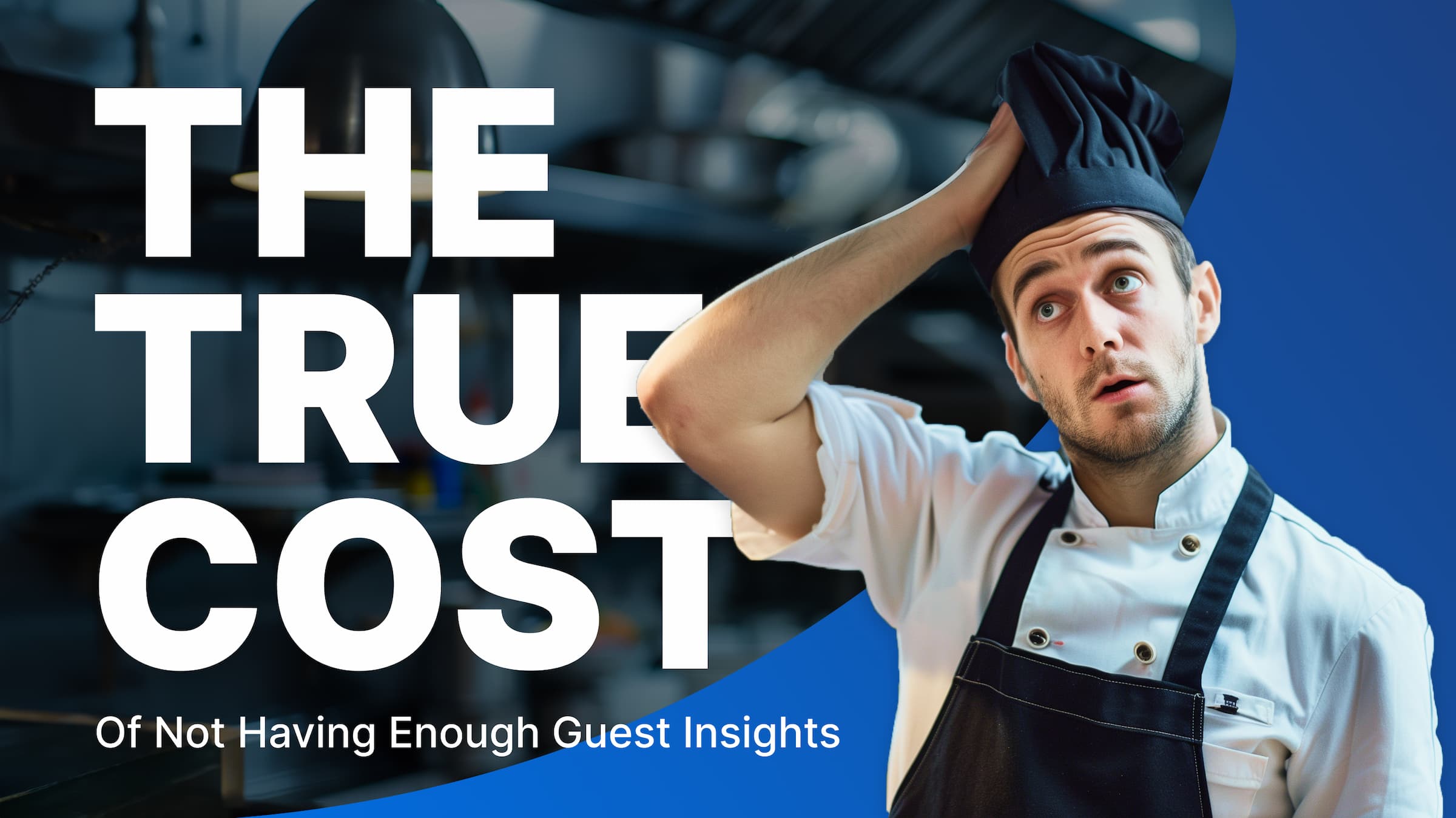Insights & Updates
Latest from Tattle
Discover trends, tips, and insights to elevate your restaurant operations.
Discover trends, tips, and insights to elevate your restaurant operations.

In this day and age, guest insights are the most important cogs in the restaurant machine.
Without sufficient guest insights, there is no accurate understanding of what needs to be done, where it needs to be done, when it should be done, or how it should be done.
These insights are distinctly different from sales metrics (which are lagging indicators of success, not leading indicators) and generic metrics (such as NPS, OSAT, NSAT, and others).
The insights that restaurants aren’t collecting are as follows:
Operational categories
Operational factors
Operational cross-sectioning
Menu item-level satisfaction
Let’s evaluate the true cost of not having this data, along with how restaurant brands can collect these insights.
This one goes without saying. The inability to get a consistent, statistically-significant look into guest and menu sentiment will ensure that problems stick around for weeks, months, or even years longer than they need to.
These issues could be major or minor – but regardless of severity, customers will have subpar experiences, won’t return as frequently, and not refer to friends and family.
And ultimately, revenue will be lost.
Here’s an example of a nuanced issue that Tattle’s real-time feedback data was able to catch:
Through Tattle, MOD Pizza began to see negative comments from guests that the salad portioning was inconsistent from visit to visit. They quickly realized that there wasn’t a process in place to make sure it was the same size every time, so MOD implemented a new tub and “size scooper” to ensure consistency. As a result, the negative guest comments about salad portioning were eliminated thereafter.
What would have been the financial ramifications if an issue like this remained undetected and unresolved?
More importantly, how many of these smaller issues are sitting right beneath the noses of restaurant operators, but they don’t have the tools or ability to identify them?
And even more than that, how much is the bottom line hurt by the cumulative hidden issues across a restaurant brand?
Tattle makes certain that death by a thousand cuts is never on the menu.
A lack of data-driven feedback can lead restaurants to continue inefficient practices that could be costing them time and money.
Tattle identified a rather stunning operational inefficiency recently for one of our partners – once again, this is the sort of stuff that is pervasive across restaurant brands, but they just don’t have the means to spot it.
To the story, one of our partner brands found out that the mere inclusion of a beverage would lead to a lower probability of a guest having a 5-star experience.
It was a peculiar discovery, no doubt.
After arming themselves with this data, the team did some digging and discovered that dine-in guests could easily grab the drink themselves before paying, but delivery and takeout orders required staff members to walk around the counter, go to the fridge, and grab the drink for the order.
This extra step caused order accuracy to drop significantly.
The solution? By adding a smaller beverage fridge under the counter, the staff was able to easily grab the drink for the order and not overlook it.
How many customers didn’t return because they were given the wrong drink?
How many wrote Yelp reviews with fewer stars because of this inefficiency?
How much money was lost because a prospective customer saw a star rating of 3.9 when it could have been a 4.2?
Multiply this line of questioning across every unseen inefficiency and the result is staggering. The ripple effect is real in the restaurant space.

Restaurants often make decisions based on assumptions rather than data, which can lead to misaligned operational adjustments, menu changes, or marketing spend that ultimately does not resonate with guests.
This is the category in which catastrophically-poor decisions can be made. Having a full visibility into your guest satisfaction and operations increases your ability to make sound business decisions that will have a strong positive impact on revenue.
“Before Tattle, we thought our online ordering process was great – but Tattle showed us it’s actually our worst-performing category!” said Michael Schatten, SVP of Operations at the fast-growing, 28-unit Carrot Express. “ now making changes to our online platform … but we never would have known it without Tattle.”
As another example, the Fat Boy’s Pizza brand made an executive decision to cut costs by going with a less expensive cheese supplier. They believed they were saving $300k annually, but – as it turns out – their satisfaction metrics took a huge hit and they realized that they had lost $500k because of the cheese supplier switch.
The only way they knew what happened was by having Tattle govern the intiative, which soon validated using real customer data that the wrong decision was made.
The Carrot Express and Fat Boy’s Pizza teams assumptions. It happens all the time, regardless of whether a brand is enterprise-level or a simple mom-and-pop shop.
Acting upon gut hunches – and not tracking the outcomes – have been a staple of the restaurant industry for decades. Not anymore, not with Tattle insights.
It’s almost impossible to seamlessly integrate new technology into pre-existing ordering processes (especially in the era of AI). Being able to make fast adjustments to a new rollout of technology is imperative.
Consumers want to help restaurants adopt new technologies that will make their experience better, but that can only happen with access to granular surveys that draw out the entirety of the experience from the customer – and provide the insights in real-time.
Here’s something that Tattle helped with here.
The Southern Classic Chicken brand recently installed a new drive-thru monitoring system (similar to McDonald’s) to better understand the pacing within their drive-thru. The week after this system was installed at their stores, they noticed a sharp decline in their accuracy and speed of service scores within Tattle.
Upon further investigation at their stores, they found that employees were trying to move too fast, resulting in less accurate orders and guests feeling rushed through the drive-thru. They’re now working to balance the accountability of the drive-thru monitoring system with providing the highest accuracy possible.
This is just one of many examples in which implementing new technology has unexpected and unintended consequences in both operations and guest satisfaction.
Again, we go back to the same line of questioning:
How many issues like this happen when rolling out new tech?
How much do the negative effects impact online sales channels, such as Yelp or Google?
How much does a lack of problem detection hurt the bottom line?
There are some finer points in this category, but incredibly-important ones nonetheless.
First, did you know that you can have an item that sells really well, but has poor satisfaction?
The typical example is a fun, exciting LTO that gets a lot of talk online. However, the build is complex and the accuracy is much lower than the rest of the menu. This means guests come in droves for this new item and many never come back because of a poor execution of the product.
Lost retention, referrals, and revenue – all from an item that has genuinely fantastic sales numbers.
This is why guest feedback across each menu item is so important. It allows you to check to see if satisfaction is high and menu items are driving new guests to be return visitors. If sentiment is low, you can make adjustments or pull the item.
Secondly, did you know that Operational Resilience measures your ability to maintain 5-star guest experiences even if a particular item's toppings or ingredients are missing?
Using the guest’s perceived accuracy of an individual item in conjunction with the satisfaction of their entire meal, you can tangibly see where you have opportunities to simplify complex builds while maintaining high sentiment.
There are so many small things that add up when it comes to optimizing your food costs and builds, only being unlocked through the power of real-time, statistically-significant feedback data.
Poor crisis management: In situations where immediate feedback could mitigate a poor guest experience, the absence of systems like Tattle can lead to unaddressed complaints that ultimately escalate to larger issues.
Loss of competitive edge: In the highly competitive restaurant industry, the ability to rapidly adapt to guest preferences and improve service can add up to significant impacts your market position.
Decreased revenue opportunities: Lack of insight into guest preferences can result in missed opportunities for upselling or promoting items that guests are more likely to enjoy and pay a premium for
The Tattle guest feedback platform solves all of the above problems, saving restaurant brands of all sizes from massive headaches and financial loses that come from a lack of reliable guest insights.
Automatically collect 55+ data points per survey:
Visualize data in an intuitive, accessible dashboard:
That’s truly just the beginning of the incredible capabilities of the Tattle platform. Check out the interactive tour below or watch a demo of the platform (https://get.tattleapp.com/request-demo/).

Alex, a intelligence and analytics expert, formerly led Customer Excellence programs at Blaze Pizza and Dunkin'. Now, he oversees LTO testing, operational analysis, and ROI optimization for Tattle partners.